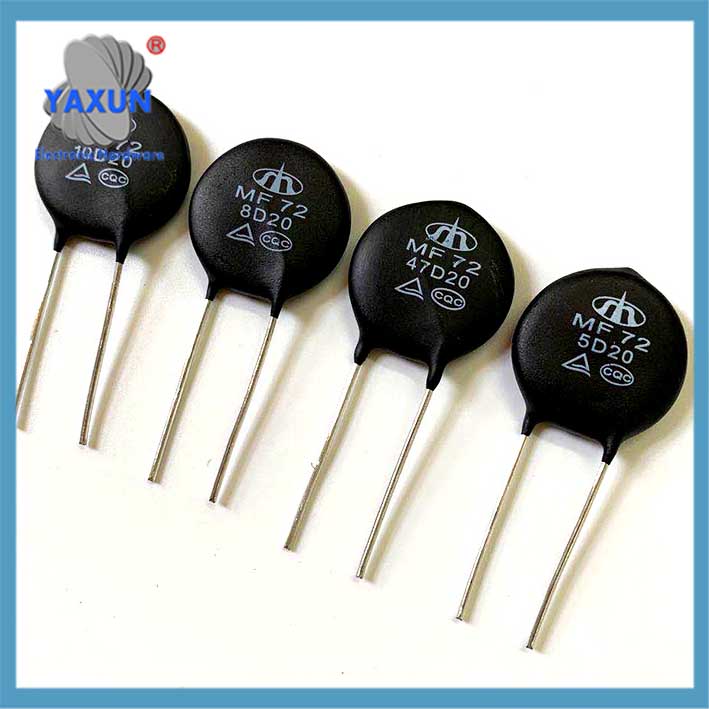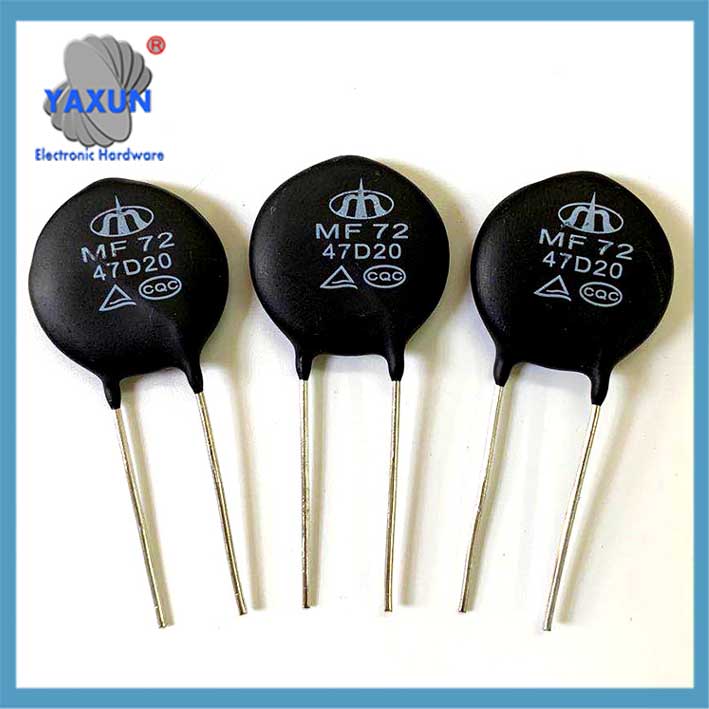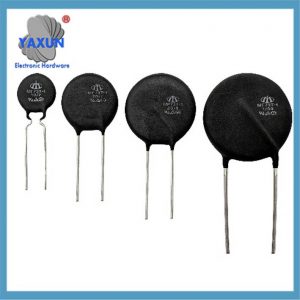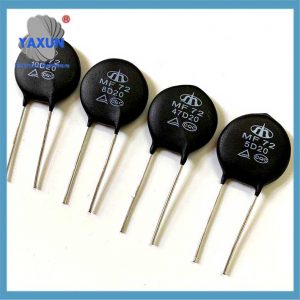Produktų kategorijos
- Šilumos saugiklis 32
- Paviršiaus laikikliai 12
- Termistorius 36
- PCB kalno saugiklių laikiklis 27
- Laidų diržai 6
- Ašmenų saugiklių laikikliai 17
- Termostatas 50
- Elektrinis saugiklis 24
- Automobilių temperatūros jutiklis 7
- Šilumos grandinės pertraukiklis 22
- „Fuse Box Holder“ 36
- Temperatūros jutiklis 75
- Šiluminis jungiklis 68
- Automobilių saugiklis 20
- Varžtas žemyn 8
Produktų žymos
Galios termistorių pritaikymas ir pasirinkimas
Kas yra galios termistorius? Galios termistorius, Taip pat žinomas kaip galios NTC arba dabartinis ribotuvas, yra komponentas, skirtas slopinti inksto sroves elektros grandinėse. Jis naudoja neigiamos temperatūros koeficiento savarankišką charakteristiką (NTC) termistorius, kad apribotų aukštas sroves, kurios gali išaugti, kai įjungta grandinė.
Power thermistor (mainly negative temperature coefficient NTC type) is a key component for suppressing surge current in electronic circuits. Its main parameters, selection points and application scenarios are as follows:
aš. Core functions and principles
Surge current suppression
At the moment of power startup, the NTC resistance value connected in series in the input circuit is high, which can limit the peak current; after power is turned on, the resistance drops rapidly due to heat (power consumption can be ignored), ensuring the stable operation of subsequent circuits.
Negative temperature characteristics
The resistance value decreases exponentially with increasing temperature: R(T)=R0⋅eB⋅(1T−1T0)R(T)=R0⋅eB⋅(T1−T01) (R0R0 is the resistance value at 25℃, BB is the material constant).
How it Works:
High Initial Resistance:
When power is first applied, a power thermistor has a high resistance, which limits the initial inrush current.
Self-Heating:
As the current flows through the thermistor, it generates heat, causing its resistance to decrease.
Resistance Decrease:
The reduction in resistance allows the circuit to draw the necessary operating current without the initial surge.
Privalumai:
Protects Equipment:
By limiting the inrush current, power thermostats prevent damage to sensitive components and equipment.
Reduces Power Loss:
The resistance decrease through self-heating reduces power loss compared to using a fixed resistor.
Energy Savings:
Lowering power loss can lead to energy savings in applications like switching power supplies and other electrical devices.
II. Key parameters and selection points
| Parametrai | Definition and selection significance | Typical value/range |
| Rated zero power resistance (R25) | The nominal resistance at 5°C determines the initial surge suppression capability. Calculation formula: R25≈U2⋅IsurgeR25≈2⋅IsurgeU (UU is the input voltage, IsurgeIsurge is the surge current) | Commonly used 2.5Ω, 5Oi, 10Ω±(15-30)% |
| Maximum steady-state current | The current that can be sustained for a long time at 25℃, needs to be greater than the circuit working current | Depending on the model 0.5A~tens of amperes |
| Residual resistance | The minimum resistance value at high temperature (such as 100℃), affecting the normal power consumption of the circuit | About 1/10~1/20 of R25 |
| B value | Material constant (measured at 25℃~50℃), determines the slope of the resistance-temperature curve; high B value responds quickly but has high cost | 2000K~6000K |
| Šiluminė laiko konstanta | Response speed index, patch type (such as SMD) can reach seconds | Glass seal/enameled wire type about 10~60 seconds |
Note: Example of model identification MF72-10D-9:
10: R25=10Ω.
D: Disc package
9: 9mm skersmens;
III. Typical application scenarios
Power supply equipment: Input surge suppression of switching power supply, UPS, adapter;
Lighting system: Anti-shock protection of LED driver, ballast, lighting distribution box;
Pramoninė įranga: Motor start, industrial power supply, medical instrument;
Buitinė technika: Air conditioner, refrigerator compressor start protection;
IV. Selection and avoidance guide
Current matching
The maximum steady-state current needs to be greater than 1.5 times the actual working current to avoid continuous heating and failure.
Heat dissipation design
In high-power scenarios, sufficient spacing or auxiliary heat dissipation is required to prevent excessive temperature rise from causing insufficient residual resistance.
Extreme temperature
The operating temperature range is generally -55℃~+125℃. Glass-sealed models (resistant to 150℃) are preferred in high-temperature environments.
V. Package and performance comparison
| Package type |
Privalumai | Applicable scenarios |
| Epoxy resin | Maža kaina, good waterproofness | Buitinė technika, ordinary power supplies |
| Glass package | Atsparumas aukštai temperatūrai (> 150 ℃), greitas atsakymas | Pramoninė įranga, automotive electronics |
| Surface mount type (SMD) | Mažas dydis, suitable for high-density PCB | Compact power module |
Tip: Be cautious in frequent switching scenarios – NTC may lose surge suppression capability when insufficient cooling is insufficient. Šiuo metu, a parallel relay bypass can be connected.
Susisiekite su mumis
Laukiu jūsų el. Pašto, Mes jums atsakysime 12 Valandos su vertinga informacija, kurios jums reikėjo.
 English
English Afrikaans
Afrikaans العربية
العربية বাংলা
বাংলা bosanski jezik
bosanski jezik Български
Български Català
Català 粤语
粤语 中文(简体)
中文(简体) 中文(漢字)
中文(漢字) Hrvatski
Hrvatski Čeština
Čeština Nederlands
Nederlands Eesti keel
Eesti keel Suomi
Suomi Français
Français Deutsch
Deutsch Ελληνικά
Ελληνικά हिन्दी; हिंदी
हिन्दी; हिंदी Magyar
Magyar Bahasa Indonesia
Bahasa Indonesia Italiano
Italiano 日本語
日本語 한국어
한국어 Latviešu valoda
Latviešu valoda Lietuvių kalba
Lietuvių kalba македонски јазик
македонски јазик Bahasa Melayu
Bahasa Melayu Norsk
Norsk پارسی
پارسی Polski
Polski Português
Português Română
Română Русский
Русский Cрпски језик
Cрпски језик Slovenčina
Slovenčina Slovenščina
Slovenščina Español
Español Svenska
Svenska ภาษาไทย
ภาษาไทย Türkçe
Türkçe Українська
Українська اردو
اردو Tiếng Việt
Tiếng Việt







